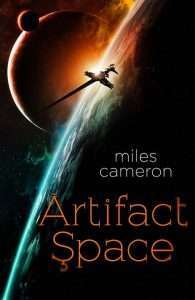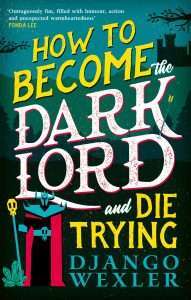Adrian Collins's Blog, page 42
September 18, 2024
REVIEW: Falling Into Oblivion by Aaron M. Payne
Aaron M. Payne comes blazing onto the scene full throttle with Falling Into Oblivion, a dark and electrifying cyberpunk murder mystery with an air of danger, urgency, and intrigue that is so addictive, it should honestly be criminal. It’s giving a bit of Dresden Files mixed with Neuromancer set against the backdrop of a neon-infused version of Batman’s Gotham City, and yet it is somehow also totally its own unique thing.
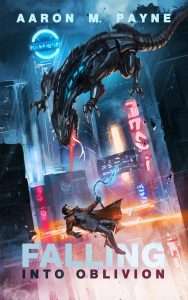 Through the eyes of local police detective Sol Harkones, we are sucked into the dark and deceptively alluring underworld of Nox City where corruption and danger lurk around every grimy corner. After another unrewarding day of work, he wants nothing more than to go home to read his young daughter her bedtime story, but his latest job turns out to be something altogether more elaborate and sinister. Soon, Sol finds himself tangled in an intricate web of conspiracies involving defective bodily modifications and deadly drugs, and he would rather risk his life than turn a blind eye.
Through the eyes of local police detective Sol Harkones, we are sucked into the dark and deceptively alluring underworld of Nox City where corruption and danger lurk around every grimy corner. After another unrewarding day of work, he wants nothing more than to go home to read his young daughter her bedtime story, but his latest job turns out to be something altogether more elaborate and sinister. Soon, Sol finds himself tangled in an intricate web of conspiracies involving defective bodily modifications and deadly drugs, and he would rather risk his life than turn a blind eye.
Look, I can count on one hand the number of cyberpunk novels I have read, so it should come as no big surprise that Falling Into Oblivion felt like an excitingly refreshing story to me. The way that Payne brought this futuristic city to life in all its darkness and its glory immediately captured my imagination, and I loved how the deceptively alluring yet disturbingly unsettling ambiance just bled off every page; I truly felt like I was right there with Sol walking the dirty alleys and hunting for the next new mind-boggling clue in the investigation.
While I can see how some readers might be caught off guard by the unfiltered first person present tense narration, I personally found it to be extremely immersive and engaging. Even though I didn’t feel as emotionally invested in Sol as I would have wished for, I did feel like I understood him on a deep level, and I really enjoyed how his strong personal motivations, unwavering contrarian convictions, and relatable spiralling thoughts kept me grounded throughout this increasingly wild romp.
Moreover, Payne cleverly works a riveting ‘ticking clock’ element into the narrative through Sol’s burning desire to return home before his daughter’s bedtime, which not only organically raised the tension and personal stakes, but also added a surprising amount of heart to Falling Into Oblivion. Yet, at the same time, I also can’t deny that I felt like the breakneck pacing hindered the development of the side characters a bit, which took away some of the impact of a few twists and betrayals for me.
Still, for a narrative that spans only one frenetic evening and afternoon, it’s honestly quite astounding how much Payne was able to pack into these pages, especially in terms of layered world building and plot development. Interwoven throughout all the pulse-pounding chases, tense interrogations, and flashy fights are some seriously thought-provoking and cautionary themes on the risk of tech advancements, bodily modifications, the relentless greed of big corporations, and the devastating effects of expanding class division, which is exactly what will make Falling Into Oblivion linger on in my mind despite its short length. Also, we’ve got mech monsters and a cybernetic dragon, and if that doesn’t make this story memorable and prove that it stands out from the crowd, then I don’t know what will.
While this first instalment in the Tendrils of Chrome series has a relatively self-contained arc and wraps up its core mystery in a satisfying if slightly abrupt way, I am still left with so many burning questions and already can’t wait to return to Nox City to dig even deeper into this world and its characters. Whether you are a cyberpunk aficionado or a newbie to the genre, I think Falling Into Oblivion is a must-read for anyone who just wants to escape into a short yet unforgettable romp that is bursting with imagination, action, mystery, and heart.
Thank you to the author for providing me with an eARC in exchange for an honest review. All opinions are my own. Falling Into Oblivion is scheduled for release on October 4th, 2024.
The post REVIEW: Falling Into Oblivion by Aaron M. Payne appeared first on Grimdark Magazine.
September 17, 2024
Grimdark is a State of Mind
In 1964, when American Supreme Court Justice Potter Stewart was asked to define obscenity so the laws could effectively determine the difference between art and pornography, he said “I know it when I see it.”
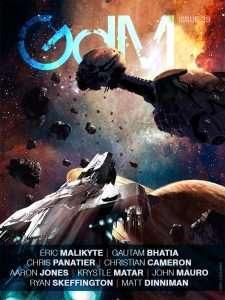 Not exactly a legally binding definition, right? (Relax, I’m not comparing Grimdark to pornography… but more on that later.)
Not exactly a legally binding definition, right? (Relax, I’m not comparing Grimdark to pornography… but more on that later.)
It’s a question I’ve been asking myself ever since I first encountered the term Grimdark, which was around the same time I started making connections in indie SFF publishing. Is it nihilism? Is it bleak? Is it morally grey? Is it borderline splatterpunk? Or is it, as Mark Lawrence (does he need any further introduction in these hollowed pages?) once opined, a genre built on the most tenacious hope there was, a stubbornness determination to try even in the face of certain doom. Whether that doom is from without (the world or other characters in it) or from within (the protagonist’s overwhelming flaws) varies from story to story, but is indeed a familiar archetype within books under the Grimdark spectrum.
Perhaps because of the way authors use the existence of hope in their stories as evidence against their inclusion, Grimdark gathers to itself a reputation of being trauma porn (see, I’m not the one who drew the parallel, someone else drew it for me long before I was a proud member of the community) or the territory of the nihilistic edgelord who shocks for shock’s sake. But I have to admit, I am inclined to agree with Mr. Lawrence. Grimdark can be those things, sure, but so can many genres that dabble in dark. Horror, for example, or true crime, or any genre—fiction or nonfiction—that deals with stories of war, or genres that deal with deep, generational traumas, etc.
To me, the parallels between Grimdark and the attempt to define obscenity/pornography are fascinating. Art that examines (dare I say, celebrates) the extreme edges of the human condition are divisive and hard to define. What does extreme even mean, after all? The definition will be different for every one of us, whether we like it or not. We’ll know it when we see it.
So, if the author doesn’t even know the genre they’re writing, where does Grimdark even come from? And why do the authors of it seem so hesitant to claim the definition for their own bodies of work?
I’ve come to the conclusion that most creative souls have an inclination to create art that grapples with complicated expressions of humanity. That grappling is not exclusive to Grimdark. But once you add to that a certain inclination toward violence described in brutal, uncomfortable detail, a fascination with human flaws and trauma, an existential wondering about what heroism even means, maybe a bit of distrust thrown at The System , and a subversion of comfort, then you begin to build a Grimdark author.
, and a subversion of comfort, then you begin to build a Grimdark author.
Grimdark as a genre holds space for the depths of human depravity, sure, but also for the stubborn assertation that none of us are beyond hope. It gathers to it the traumatized, the broken, desperate, the wretched masses. It is built on big questions, some of them ugly, but all of them important. If heroes can only be unfailingly good, where do we, the tragically imperfect, turn to be seen and understood?
Perhaps the reason we can’t define it and only know it when we see it, is because Grimdark is the genre that sees us and claims us and welcomes us home. Even if—especially if?—we are obscene.
Grimdark is a state of mind. It declares, stubbornly and without surrender, that we all deserve stories. We all deserve art.
This essay was originally published in Grimdark Magazine #39.
The post Grimdark is a State of Mind appeared first on Grimdark Magazine.
September 16, 2024
REVIEW: Artifact Space by Miles Cameron
Artifact Space is the first science fiction novel by Miles Cameron, a pseudonym for genre chameleon Christian Cameron, who has published over forty novels across historical fiction and epic fantasy. With his debut jaunt into the greater cosmos, Cameron introduces us to the Arcana Imperii Universe and its prodigious intergalactic trade. The technological advances of this far-flung future are built on xenoglas, a rare but powerful material originating from an alien Starfish race. Xenoglas is also big business, the most coveted good transported by the enormous Greatships. What could possibly go wrong?
The Greatships are a sight to behold: sword-shaped spacefaring behemoths, kilometers in length and having cross-sections five hundred meters wide. With their several inhabitable decks, the Greatships can accommodate the population of an entire city. However, their valuable cargo also makes them the target of nefarious attacks.
Miles Cameron’s deep love of history surfaces throughout Artifact Space. I enjoyed seeing how artifacts from Earth’s human civilization are captured in the far future of the Arcana Imperii Universe. There is clear inspiration from Renaissance era sea trade, with many of the ship and port names reflecting cities from the network of trade routes known as the Mediterranean Sea Complex. But the similarities go beyond nomenclature, as Miles Cameron has transposed many of the real-world problems faced by Renaissance era seafarers to a sci-fi outer space setting.
Notwithstanding its excellent worldbuilding, Artifact Space is primarily a character-driven novel built around the lively orphan Marca Nbaro, who forges papers to become a midshipman on the Greatship Athens. Artifact Space also features a great cast of side characters including the engineer, Qaqqaq, and Marca’s friend and roommate, Thea. Despite coming from a more privileged background, Thea forms a close friendship with Marca that becomes one of the highlights of the novel. There is also some light romance, which (unfortunately) I never found quite believable.
There is nary a dull moment here as Marca faces the perils of space while struggling to heal the scars of her past. Miles Cameron’s propulsive writing races to keep up with the fast-paced action. The author’s past career as a naval officer definitely shines through in considerations of military strategy.
Altogether, Artifact Space is sure to become a favorite among fans of space opera and military science fiction. The adventure continues with Deep Black, the second and final volume of the Arcana Imperii duology.
Read Artifact Space by Miles CameronThe post REVIEW: Artifact Space by Miles Cameron appeared first on Grimdark Magazine.
September 15, 2024
REVIEW: The Light of Kasaban by Thomas Howard Riley
In The Light of Kasaban, Thomas Howard Riley spins an excitingly wondrous yet brutally emotional fantasy tale full of trauma, sacrifice, found family, and deadly magick; this book might not be a chunker, but it will hit you like a brick in the gut. 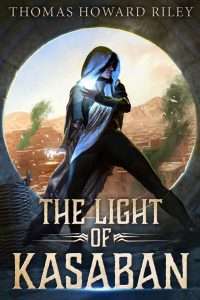 Set in a scorching hot desert city every bit as brutal as its oppressive overlords, The Light of Kasaban tells the story of Saya Ani Anai, a poor young teacher of forbidden magick who has dedicated her life to protecting orphaned magi kids from the brutal religious order that wants them all dead. Crumbling under the yoke of oppression and battling enemies both within and without, Saya will have to risk everything to seize a chance at survival, or else her life and hopes will all go up in flames.
Set in a scorching hot desert city every bit as brutal as its oppressive overlords, The Light of Kasaban tells the story of Saya Ani Anai, a poor young teacher of forbidden magick who has dedicated her life to protecting orphaned magi kids from the brutal religious order that wants them all dead. Crumbling under the yoke of oppression and battling enemies both within and without, Saya will have to risk everything to seize a chance at survival, or else her life and hopes will all go up in flames.
“The light of Kasaban burns all it touches, love, hope, joy. Nothing can withstand it. The heat bakes flesh and stone. The winds whisper like flames. The sun does not forgive.”
Now, for some inexplicable reason, Thomas Howard Riley has always been one of those authors whose writing I just knew I was going to love; dark, character-driven and emotionally destructive stories? Say less, please. And lo and behold, The Light of Kasaban was exactly what I was hoping it would be, instantly reminding me of the styles of my favourites like Jay Kristoff’s Nevernight and Krystle Matar’s Legacy of the Brightwash, while also feeling incredibly fresh and unique.
From the very first page, Riley just sets the tone and creates an all-consuming sense of dread that kept me in a chokehold from start to finish. I immediately latched onto Saya, not because she is so perfectly loveable, but because she is so tragically human and relatable in her fears and flaws. Moreover, this atmospheric desert city setting might be hot, but I’d dare to say that it almost pales in comparison to Saya’s own fire and spunk, which just made me love her even more.
“She could not be the one who broke down. She could not be the one who collapsed in tears. She could not be the one who desperately sank into the embrace of someone else and begged them to take over the strain for her. Kasaban offered no solace for those who broke. It did not pick up those who fell. It did not wipe away the tears of those who wept.”
I personally really enjoyed how, in a weird way, the first half of The Light of Kasaban has a bit of a slice-of-life vibe to it, though don’t mistake that for me saying this is a cozy story. It’s just that we get such a terrifyingly intimate look into Saya’s troubled mind as she goes about her days risking her life to protect the children she has taken under her wing, which allows for such an organic way of getting invested in these characters, for better or worse (ouch, my poor heart!).
Riley really doesn’t shy away from exploring the darker realms of the human mind as well as the depravities that humanity is capable of, especially in the occasional secondary POV from the deliciously hateable yet terrifyingly fascinating antagonist. The way that sensitive topics of complex trauma, grief, religious zealotry, oppression, genocide, sexual harrassment, morality, and sacrifice are woven into this narrative is confronting in the best way, and even though some scenes almost made me a bit too uncomfortable, I just loved how Riley’s elegant yet knife-sharp prose only made those visceral scenes and difficult themes hit home all the harder.
“Hiding to survive was better than fighting every moment of every day to live. Invisibility was better than armor. No one could fight the Priests. She had seen foolish people try.”
Though, despite the darkness and depravity, I think The Light of Kasaban is at its core a fiercely powerful story of defiance, hope and love. Saya’s emotional journey throughout this story is so beautiful to witness, and I absolutely loved the wholesome dynamic between her and (most of) the kids. Even though some of the children felt a little better developed than others, I still think the found family vibes absolutely shine and I especially appreciated how their childhood innocence and sneaky hijinx added so much heart to the narrative.
Not to mention, the Render magic system is undeniably cool, which only increased that sense of excitement and wonder for me. I do have to admit that I didn’t fully grasp all of the intricacies and limitations of the magic, though I don’t know if that was because it was intentionally soft and elusive, or due to the fact that this story is set in Riley’s existing Luminaworld which I personally hadn’t explored before yet. In any case, for the most part I felt like The Light of Kasaban was an extremely smooth and immersive introduction to this dark yet intriguing world, and if anything, it only made me more eager to explore the world further by diving into more of Riley’s works as soon as possible.
“One of these tomorrows will lead us to a better life. As long as the tomorrows keep coming, one of them will be that day. And the good thing about tomorrows is that there always is one.”
With the satisfyingly hopeful yet dreadfully ominous note that this story leaves off on, I am beyond curious to see where these scarred yet strong characters go next from here. If you like the sound of a dark fantasy tale that is first and foremost an intimately vulnerable character-study, but which still offers plenty of high stakes action, risky thievery, and excitingly dangerous magic, then I can’t recommend The Light of Kasaban highly enough!
Thank you to the author for providing me with an eARC in exchange for an honest review. All opinions are my own. The Light of Kasaban is scheduled for release on September 17th, 2024.
The post REVIEW: The Light of Kasaban by Thomas Howard Riley appeared first on Grimdark Magazine.
September 14, 2024
REVIEW: The Escher Man by T.R. Napper
Last Updated on September 15, 2024
We return to T.R. Napper’s wider neon-soaked cyberpunk future in the stand-alone novel, The Escher Man (Titan, 17th September), a brutally barnstorming, mind-bending tale of revenge, memory manipulation, and the downtrodden sticking their middle fingers up at the world order.
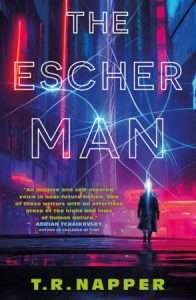 Endel “Endgame” Ebbinghaus is a cartel enforcer in Macau, cashing cheques and breaking necks as required by his terrifying boss, Mr. Long. He’s a violent man, but he’s also a family man, and with this being his last day on the job, it’s time for him to get out. But in a world where control goes beyond a contract and into the deepest kind of manipulation possible–your memories–getting out from under the thumb of one of the most vicious men in Asia is not going to be simple, or painless, or without a very tall stack of mangled bodies piling up.
Endel “Endgame” Ebbinghaus is a cartel enforcer in Macau, cashing cheques and breaking necks as required by his terrifying boss, Mr. Long. He’s a violent man, but he’s also a family man, and with this being his last day on the job, it’s time for him to get out. But in a world where control goes beyond a contract and into the deepest kind of manipulation possible–your memories–getting out from under the thumb of one of the most vicious men in Asia is not going to be simple, or painless, or without a very tall stack of mangled bodies piling up.
The Escher Man is an exciting approach to storytelling. Amongst the things you’d expect in a cyberpunk novel–plenty of grit, snark, technology, violence, and political commentary–Napper takes you into a world of Chinese military and cultural occupation forced on the most culturally diverse region on earth, Asia, as China becomes the premier military power on the planet. Napper’s lived experience and research into the nuances of Asia bring a world to life that feels real and possible and utterly fucking terrifying. In The Escher Man you aren’t just in a non-descript, American-style city with Kanji lettering on the signs–you are in the cultural melting pot of future Asia in every way.
Against this backdrop, the story structure uses the manipulation of memory heavily, in a way that I haven’t enjoyed (outside of Napper’s other works) this much since watching Guy Pearce in Memento. I have long loved the way Napper plays with the theme of memory in the universe he’s built. It’s a consistent theme throughout his works, such as Neon Leviathan, 36 Streets, and Ghost of a Neon God–whether it plays a key role like it does in The Escher Man or it’s in the background of a story with a different primary theme. Memory (its ownership, manipulation, damage, monetisation, criminalisation, and loss) can be a really tricky theme to construct a story around. I think it can go wrong in so many ways. In The Escher Man, Napper has delivered this core structural theme of the story perfectly.
Endel’s memory has been overwritten and re-written time and time again (to protect his criminal overlords from Endel’s likely eventual capture and interrogation) to the point where he’s at the juncture of becoming a mindless drone of instant violence. He’s become almost a parody of a gangster hitman living hard. A daily wake up note from the version of himself who went to sleep the night before helps guide you, the reader, through Endel’s story. I loved the way spirits of memory showed up and impacted Endel’s daily world view, how the memories shifted and changed as they were impacted by his waking hours and the work of Mr. Long. The further we got in, and the more complex Endel’s moves to achieve his goal, the more this aspect of the book appealed to me.
Napper’s cyberpunk voice is on point. Endel and the supporting cast are brutal, savagely damaged humans doing horrible things to meet their own ends, but there is always heart at the guts of each of them. The way he’s woven in his experience working for a decade in the poorest parts of South East Asia to create a very real, very possible feeling future Asia Pacific, where the Former United States is a spent force, Europe is a wasteland, and China has taken over to be the prominent planetary superpower, is perfect. In particular the c-glyph tool–a memory pin and essentially Google inside your head–plays a key part here as he extrapolates out a very real theme for us today: can you ever really trust a technology company to do the right thing by its users?
If there is one author alive and writing today capable of picking up the cyberpunk banner and waving his fist at the future of our species whenever Richard Morgan hangs up his boots, I think it’s T.R. Napper. Rarely does a book so encapsulate its genre while also pushing the boundaries of its audience. The Escher Man is fucking brilliant.
Read The Escher Man by T.R. NapperThe post REVIEW: The Escher Man by T.R. Napper appeared first on Grimdark Magazine.
September 13, 2024
REVIEW: The Savage Sword of Conan #4
Much like the prelude Free Comic Book Day issue, this double-sized installment of The Savage Sword of Conan #4 helps lay the groundwork for the Conan the Barbarian: Battle of the Black Stone multi-character crossover event miniseries. In this issue, each of the miniseries’ main characters has a close encounter with either the titular black stone that has been a recurring motif throughout the first twelve issues of Titan Comics’ Conan the Barbarian title or the mysterious eye-shaped sigil associated with it.
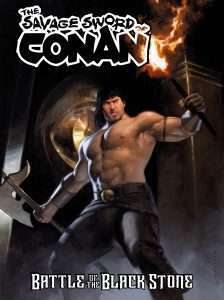 After a brief introductory page written by Jim Zub describing the concept behind the Battle of the Black Stone project, the issue opens with “Birthright in Black,” a Conan story by Zub with art by Fernando Dagnino. Conan experiences a vision in which he devolves to a primitive pre-human state. In a scene reminiscent of Stanley Kubrick’s 2001, Conan battles against other savages at the foot of the black stone obelisk. As he fulfills the obelisk’s bloodlust, he is rewarded with earthly pleasures, but the barbarian soon finds himself chafe under the malign influence of the obelisk. When Conan comes to, he’s back in the Aquilonian frontier, suggesting that this story takes place shortly after the Free Comic Book Day issue. While the artwork is fantastic, the hallucinatory nature of the comic’s event makes it hard to get too excited about the events of the story. Prophetic or not, it’s all a dream.
After a brief introductory page written by Jim Zub describing the concept behind the Battle of the Black Stone project, the issue opens with “Birthright in Black,” a Conan story by Zub with art by Fernando Dagnino. Conan experiences a vision in which he devolves to a primitive pre-human state. In a scene reminiscent of Stanley Kubrick’s 2001, Conan battles against other savages at the foot of the black stone obelisk. As he fulfills the obelisk’s bloodlust, he is rewarded with earthly pleasures, but the barbarian soon finds himself chafe under the malign influence of the obelisk. When Conan comes to, he’s back in the Aquilonian frontier, suggesting that this story takes place shortly after the Free Comic Book Day issue. While the artwork is fantastic, the hallucinatory nature of the comic’s event makes it hard to get too excited about the events of the story. Prophetic or not, it’s all a dream.
“Blood From a Stone” is another Solomon Kane story written and illustrated by Patch Zircher. While I didn’t feel like the plot of Zircher’s three-part “Master of the Hunt” series in previous installments of The Savage Sword of Conan quite lived up to the phenomenal artwork, this outing is a more successful one. Solomon Kane finds himself thrown in with a handful of mercenaries and remnants of the Hungarian military, raiding Turkish troops for supplies. When several of his comrades suffer mysterious deaths, their hearts removed from their bodies, Kane surmises that dark sorcery is afoot. Separated from Conan by thousands of years, Kane ends up having his own encounter with the black stone obelisk and its corrupting influence. The historical grounding of this story adds to its appeal, and the monster appearing at its climax is visually striking. I hope Zircher will contribute more Solomon Kane stories to future issues of The Savage Sword of Conan, they have been some of the strongest work to be featured in the current incarnation of the magazine.
Written by Jim Zub with artwork by Dean Kotz, “Ever and Never Beyond” deals with Brissa, the Pictish scout who joined forces with Conan during the Bound in Black Stone story arc (Conan the Barbarian issues #1-4). Readers of the monthly title may recall that Brissa was separated from Conan at the climax of Conan the Barbarian #4 and presumed dead. Those who read the 2024 Free Comic Book Day issue already know that Brissa is alive, if perhaps existing outside of her normal era, but this short comic fills in the circumstances surrounding her disappearance from the black stone citadel. Like Zub’s Conan story in this issue, this episode feels vaguely superfluous, like something that will be briefly recapped in a few panels of the Conan the Barbarian: Battle of the Black Stone miniseries proper.
Set in 1935, “Horror from the Tomb” is a pulp adventure by Jeffrey Shanks and artist Eryk Donovan, starring Professor John Kirowan and his two-fisted companion John Conrad of author Robert E. Howard’s Cthulhu Mythos tales. Kirowan and Conrad journey to the Sinai Peninsula of Egypt to examine a colleague’s archaeological findings. It’s not long before the duo encounters a corpse inscribed with an unsettling eye-shaped rune, along with evidence that their host has fallen prey to an otherworldly threat. The general premise is familiar but well-executed, and after reading so many non-fiction essays by Jeffrey Shanks in the pages of Conan the Barbarian and The Savage Sword of Conan it was exciting to see him try his hand at a comic script.
“Matrimony,” by Fred Kennedy and Andy Belanger is perhaps destined to be the most controversial installment of this issue. It features Robert E. Howard’s other hot-blooded red-headed swordswoman: not Red Sonya of Rogatino (the initial inspiration for the Red Sonja comic book heroine), but Dark Agnes de Chastillon. For reasons that remain slightly obscure, Dark Agnes creeps into the estate of Duke Ilya Kursonovich, searching for evidence of occult misdeeds. Upon encountering the dark eye sigil emblazoned on a tapestry, Agnes abruptly loses consciousness. The audience is then presented with a truncated retelling of Dark Agnes’ origin story—Howard’s short story “Sword Woman”—but modified to include supernatural elements. While the original Dark Agnes is a fierce and entertaining character, her depiction here does her a disservice. Her story here is muddled, with no real resolution. In an issue full of realistic artwork, Belanger’s anime styling also sticks out like a sore thumb.
Fortunately, the issue concludes on a strong note with “Black Oasis,” by Ron Marz and artist Mike Perkins. This story focuses on Texan adventurer Francis Xavier Gordon, known to enemy and ally alike as El Borak (Arabic for “The Swift”). Having rescued a young prince from a rival tribe, El Borak and the youth flee across the Arabian desert, pausing to take shelter in the ruins of an ancient temple. Despite his misgivings about the eerie atmosphere within the temple and the prominently displayed dark eye sigil, El Borak uses it as the stage for his final showdown with the prince’s pursuers. Compared to the other comics in this issue, the supernatural element is nicely understated. This comic also succeeds where the Dark Agnes short “Matrimony” fails, by effectively demonstrating how El Borak is a cool character worthy of the audience’s support and enthusiasm. El Borak’s first appearance in the Titan Comics incarnation of The Savage Sword of Conan is a success, and I hope to see more by the same creative team.
Overall, The Savage Sword of Conan #4 is a brisk and entertaining read. Given the goal of this issue there’s a certain degree of “sameyness” across the issue’s stories, with each installments’ hero encountering either the black stone obelisk or the dark eye sigil that accompanies it, but there was enough variety between settings and the telling of each chapter to keep the issue from feeling monotonous.
Read The Savage Sword of Conan #4 by Jim Zub (W), Fernando Dagnino (A) et al.The post REVIEW: The Savage Sword of Conan #4 appeared first on Grimdark Magazine.
September 12, 2024
REVIEW: The Council of Athyzia by D.H. Hoskins
Last Updated on September 13, 2024
In The Council of Athyzia, D.H. Hoskins spins a high fantasy tale full of conspiracies, schemes, and brutal back stabbings and betrayals that rivals even A Song of Ice and Fire’s level of complex political drama. Here, treacherous tongues are wielded like weapons, and words soon prove more dangerous and deadly than any magical battle could ever be.
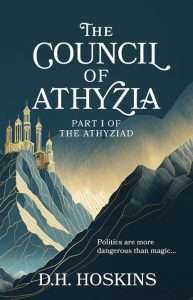 Starting where most fantasy books end, The Council of Athyzia explores what would happen to a world when the dark lord has finally been defeated after 25 years of terror. Imagine a true historic peace conference like Vienna or Paris, except here we have elves, dwarves, creatures and different factions of humans coming together to forge a new path forward; can they set aside their personal goals to maintain peace and unity without a common enemy, or will tensions explode and history repeat itself?
Starting where most fantasy books end, The Council of Athyzia explores what would happen to a world when the dark lord has finally been defeated after 25 years of terror. Imagine a true historic peace conference like Vienna or Paris, except here we have elves, dwarves, creatures and different factions of humans coming together to forge a new path forward; can they set aside their personal goals to maintain peace and unity without a common enemy, or will tensions explode and history repeat itself?
As someone who can get quite daunted by complex political fantasy narratives, I went into The Council of Athyzia equally curious and nervous. Now, there’s no denying that the first couple of chapters may feel a bit overwhelming with the rapid introduction of the council, but I think Hoskins does a surprisingly impressive job of establishing all the key players on the field and setting up the stakes. While some minor characters remained little more than names and titles to me, the key players really came to life and pulled me in with their fascinating complexity.
See, while there are a lot of moving pieces in The Council of Athyzia, I personally found the intimate scope of the storytelling to be a very great grounding force. Not only was Athyzia, with its ancient library and lavish rooms, a very charming and immersive setting to me, but I also just loved exploring it all through Nauveena’s eyes. With her sharp mind and tender heart, she quickly proved to be a very compelling and strong female protagonist, and I loved how she was allowed to be so realistically messy and flawed in trying to deal with all the increasingly challenging trials and tribulations that she is faced with.
Moreover, I really enjoyed the complex interpersonal relationships that lie at the heart of The Council of Athyzia, be they friendly or hostile. Especially Nauveena’s wholesome dynamic with her mentor Snorri (who is the head of the Council) and her unexpected friendship with the enigmatic witch Venefica really pulled me in on an emotional level, which only increased my personal investment, for better or worse (ouch, my poor heart!). And don’t get me started on Fallou and his schemes, that’s what I call a deliciously hateable yet somehow weirdly understandable antagonist.
Hoskins is honestly a masterful storyteller, and I really loved how his writing reminded me of my older favourite Tolkien-esque fantasy stories, except with a lot better female characters and without it feeling tired or uninspired. I especially enjoyed how the first half of The Council of Athyzia almost has a bit of a cozy and nostalgic vibe to it, and I found it quite amusing how the characters themselves even gave signs of being bored out of their minds during the tedious first council meetings. But then around the halfway mark, there is a big shocking turning point in the narrative and the ominously elusive dream/prophecy magic becomes a bigger focus, after which it just gets more and more intense with each turn of the page.
Though the focus of this story might be small, this world is just drenched in epicness (yes, here there be dragons!) and offers an impressive level of depth and nuance to its history and lore. I loved learning about the complicated conflicts between all the different races/factions through organic and dangerously charged conversations, and I found it terrifyingly fascinating to see characters jumping all around the spectrum of morality to suit their own needs. While I personally would have liked to see a bit more culture clashing or language barriers, I honestly think Hoskins did a magnificent job of bringing these diverse characters to life, and I deeply appreciated the authentic exploration of sensitive themes like racism, corruption, narcissism, morality, religious strife, cultism, and othering.
Even if you are the type of reader who, like me, couldn’t stop yawning during the Council of Elrond in Tolkien’s The Lord of the Rings, I would dare to say that Hoskins can make you fall in love with all the political power plays and riveting debates. So for all those who love classic fantasy but want things a bit darker, with more dire consequences, and a lot more nuance to the traditional good vs. evil narrative, then I can’t recommend The Council of Athyzia highly enough; this book truly has zero business being this addictive, and you better bet I am jumping into the next instalment in this exceptional trilogy the moment it releases.
Thank you to the author for providing me with a digital review copy in exchange for an honest review. All opinions are my own.
Read The Council of Athyzia by D.H. HoskinsThe post REVIEW: The Council of Athyzia by D.H. Hoskins appeared first on Grimdark Magazine.
September 11, 2024
REVIEW: The Land of the Living and the Dead by Shauna Lawless
The Land of the Living and the Dead is the latest novel by Irish author Shauna Lawless, set in her Gael Song world. This series is a superb mix of history, fantasy, and mythology and one that I have personally loved since I read Lawless’ debut novel, The Children of Gods and Fighting Men. I have recommended the series countless times, bought it as a gift, and generally not shut up about how great it is to anyone who will listen. I went into reading The Land of the Living and the Dead with the highest of expectations, and now, having finished it, it is safe to say that it is one of my top reads of the year. The super short review is this: this is a phenomenal novel. You should read it.
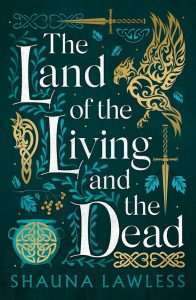 There is another time jump between The Land of the Living and the Dead and its predecessor, The Words of Kings and Prophets, and just over a decade has gone by since we last saw Fódla and Gormflaith, the series’ protagonists. It is now 1011 AD in Ireland, and the High King, Brian Boru, struggles to hold his crown and maintain a fragile peace. The struggle between the fire-wielding Fomorians and the magical Descendants still goes on, hidden from the eyes of most. Gormflaith, Brain’s queen, still hides her fire magic and newer stolen powers, and schemes to gain the crown and destroy the Descendants for good. The Descendants should be united against this threat, but they have internal struggles as not all their kind wish to dominate the mortals. Fódla must use these divisions to reveal Gormflaith’s treachery, but it will come at a significant personal cost. War seems unavoidable, but if Fódla succeeds, she will steer Ireland away from a future bathed in flames.
There is another time jump between The Land of the Living and the Dead and its predecessor, The Words of Kings and Prophets, and just over a decade has gone by since we last saw Fódla and Gormflaith, the series’ protagonists. It is now 1011 AD in Ireland, and the High King, Brian Boru, struggles to hold his crown and maintain a fragile peace. The struggle between the fire-wielding Fomorians and the magical Descendants still goes on, hidden from the eyes of most. Gormflaith, Brain’s queen, still hides her fire magic and newer stolen powers, and schemes to gain the crown and destroy the Descendants for good. The Descendants should be united against this threat, but they have internal struggles as not all their kind wish to dominate the mortals. Fódla must use these divisions to reveal Gormflaith’s treachery, but it will come at a significant personal cost. War seems unavoidable, but if Fódla succeeds, she will steer Ireland away from a future bathed in flames.
One of my favourite things about this series is that we see almost all of the novel’s events from the point of view of Fódla and Gormflaith. In their patriarchal society, seeing the women work covertly gives a unique perspective. This is shown more obviously in the scheming of Gormflaith and her obsession with furthering her Fomorian kin, and her frustration with her place in society because of her womanhood becomes more evident as the novel progresses. Fódla is a very different character, less political and less prone to using violence to solve her problems, but still not a leader in her own right. Fódla is not a gift leader or queen, but in The Land of the Living and the Dead, she is more vital than she has been in the earlier stories, particularly with her stance against her former lover, Tomas.
I must also praise Lawless for her characterisation in this series. This is true not only of the main characters of Fódla and Gormflaith but also of others. Even characters we do not hear from as much, such as Ronnat, Murchard, or Broccan, are all well-developed and elicit an emotional response from the reader. Lawless’ world is vivid and realistic; it utterly transports the reader. But her characters made this series such an excellent read for me. Even the less likeable characters are exceptionally well written. I can think of few other examples in all my reading where a depiction of an undeniably awful person gives me such a visceral reaction as when Tomas appears on the page. After reading the novella Dreams of Sorrow (which should be read after the second novel in the series and before The Land of the Living and the Dead), I did not think it was possible to dislike Tomas more. It turns out that it is.
I will accept that The Land of the Living and the Dead is not the darkest fantasy read on the market. It is a very believable historical fantasy, and its darkness is in keeping with the era in which it is set. There are vivid battle scenes, political machinations, and cloak-and-dagger murders. I think it appeals greatly to those who want an intense and intricate read. Across the whole series, Lawless covers decades of Gormflaith’s and Fódla’s lives and swirled within their fictional narratives is a host of Irish history and myth, which was a pleasure to read about.
The Land of the Living and the Dead is the third book in the Gael Song world, but I hope it will not be the last set here. Whatever Lawless has in store for us next, I will be reading it. Thank you so much to Shauna Lawless and the Head of Zeus / Ad Astra team for sending over an ARC of The Land of the Living and the Dead.
Read The Land of the Living and the Dead by Shauna Lawless
The post REVIEW: The Land of the Living and the Dead by Shauna Lawless appeared first on Grimdark Magazine.
September 10, 2024
REVIEW: The Threshing Floor by Steph Nelson
Miracles come at a price in The Threshing Floor, Steph Nelson’s new novel that is equal parts occultist horror and psychological thriller. The lead protagonist, Dalice, is a single mother working multiple jobs to care for her toddler son, Cash, who is in desperate need of a heart transplant. Broke and broken, Dalice finds new hope when a handsome stranger, Shane, enters her life, opening the possibility of companionship and, potentially, a miraculous cure.
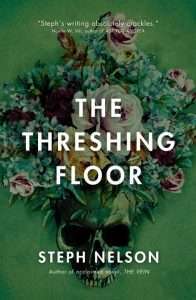 The miracle-worker in question is Shane’s younger sister, Reva, an enigmatic cult leader whose healing hands sparkle like the dust of gold. Despite her altruistic veneer, there is a deeply sinister side to Reva, who prays for healing as she preys on her unsuspecting victims.
The miracle-worker in question is Shane’s younger sister, Reva, an enigmatic cult leader whose healing hands sparkle like the dust of gold. Despite her altruistic veneer, there is a deeply sinister side to Reva, who prays for healing as she preys on her unsuspecting victims.
Steph Nelson grabbed me from the opening prologue of The Threshing Floor, which finds Dalice running in the shadows of darkness, stumbling upon what may be a torture chamber or perhaps a path toward digging her own grave. The tension builds as we learn more about the mysterious gold dust woman and her true intentions. Will Dalice remain in the cult as the price of miracles becomes too high, or will she pick up the pieces and go home?
The Threshing Floor switches perspectives while also alternating between the present timeline and the backstory of Shane and Reva’s childhoods in the early 1990s, revealing striking parallels between Reva’s traumatic childhood and the psychological abuse she inflicts on others.
The horror elements are a slow build throughout The Threshing Floor. I especially enjoyed Steph Nelson’s approach to the supernatural, which is presented in a mostly positive light while showing that the real evil may come from within. As in her previous survival horror, Sawtooth, the psychological aspects of The Threshing Floor are particularly well done.
Steph Nelson also shines with her character development, especially while showing the sacrifices that Dalice is willing to make to save her son. The romance between Dalice and Shane is presented with realistic nuance, lending amorous overtones to balance the horror. However, Reva’s interference might ultimately shatter Dalice’s illusions of love.
From its opening prologue to its unnerving final page, The Threshing Floor is an unputdownable thriller, establishing Steph Nelson as one of my favorite new voices in horror. Fans of occultist and psychological horror will find much to love here.
Read The Threshing Floor by Steph NelsonThe post REVIEW: The Threshing Floor by Steph Nelson appeared first on Grimdark Magazine.
September 9, 2024
REVIEW: How to Become the Dark Lord and Die Trying by Django Wexler
In How to Become the Dark Lord and Die Trying by Django Wexler, Davi has died 237 times, and, strapped to a torturer’s block, she’s about to die again. In this way are we introduced to our protagonist, who is trapped in a kind of death / time loop which can best be described as playing a game of Dark Souls meets Morrowind meets Boss Level.
Early on in How to Become the Dark Lord and Die Trying, it’s well established that Davi has stopped seeing the people in this world as people. Having seen them all reset, forget she ever existed, and start over as if nothing happened so many times means to her they are just things to be used or murdered to defeat the dark lord and get back to her real world of social media and Reddit. Her deaths may take minutes or years, but they always happen and she always loses to the dark lord, in whatever form the dark lord takes.
This time Davi has had enough. It’s time to switch sides from the Kingdom (humans) to the Wilders (fantasy people) and become the dark lord (while dying A LOT trying). She needs the get to the Conclave to claim her dark lordship. She’ll need a horde. She’ll need to cross lands of bandits and beasts and lords who may not be too happy she’s there. It’s time to try something different.
Up front, How to Become the Dark Lord and Die Trying is a dark comedy fantasy. Our protagonist is snarkier than Deadpool, and much like the Merc with a Mouth, we get to see her story arc move from seeing all people as something to be played with—murdered without thought, betrayed without guilt, used as minions to be thrown into the meat grinder without remorse—to caring about those under her charge. Amongst her snarky, driven, angry-at-the-world, cynical as fuck, and tired-of-this-shit attitude, we eventually find a relatively decent human being and somebody to root for. I take my hat off to Wexler for really nailing the voice of Davi. It’s a style that is really hard to get right and deliver across 100,000+ words without it becoming repetitive and boring, and Davi is nothing if not hilariously entertaining cover-to-cover.
Not to be left behind, the supporting cast are excellent, in particular Davi’s horde’s generals. The way they grow to accept Davi at her whacky best (including not understanding 90% of her non-world references, songs, and sayings) is at times hilarious and heartwarming. Their prejudices, failures, and growth make them a superb supporting cast.
I think books like this are important to the grimdark community. It’s a funny, and immensely fun read, while also delivering strong messages around how we treat each other. It’s a different kind of morally grey read to our usual fare, and while it retains so many things we like, it dials up the cheek and laughs for a nice, relevant break from the grit.
How to Become the Dark Lord and Die Trying by Django Wexler is a wildly fun tale that is going to appeal to gamers who embrace the grind just as much as to lovers of great dark fantasy books.
Read How to Become the Dark Lord and Die Trying by Django WexlerThe post REVIEW: How to Become the Dark Lord and Die Trying by Django Wexler appeared first on Grimdark Magazine.

